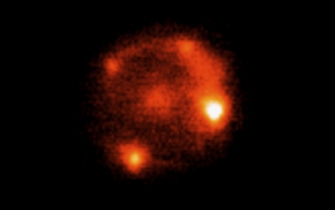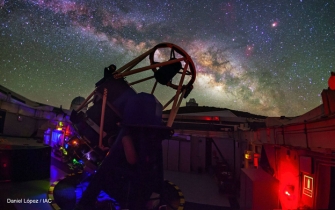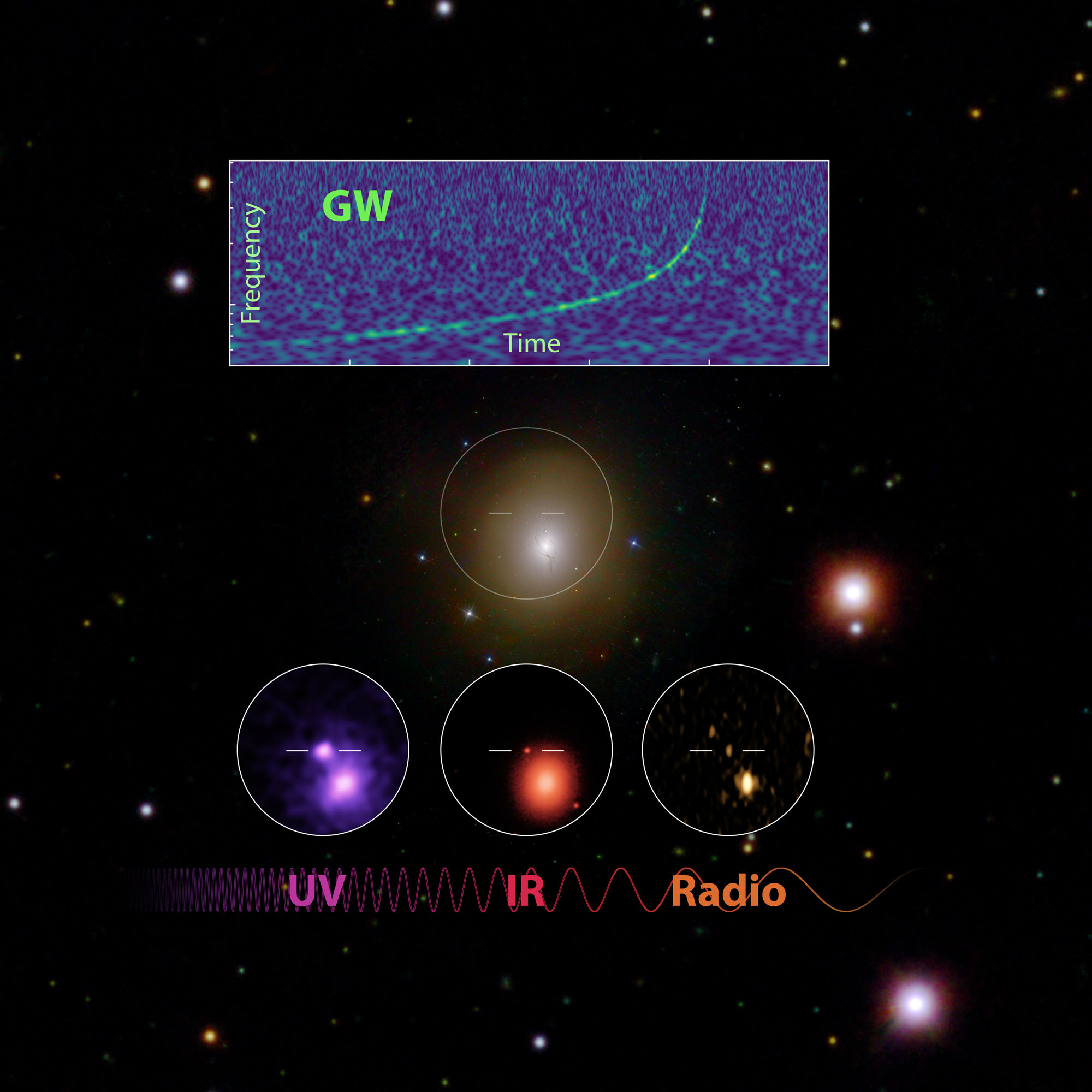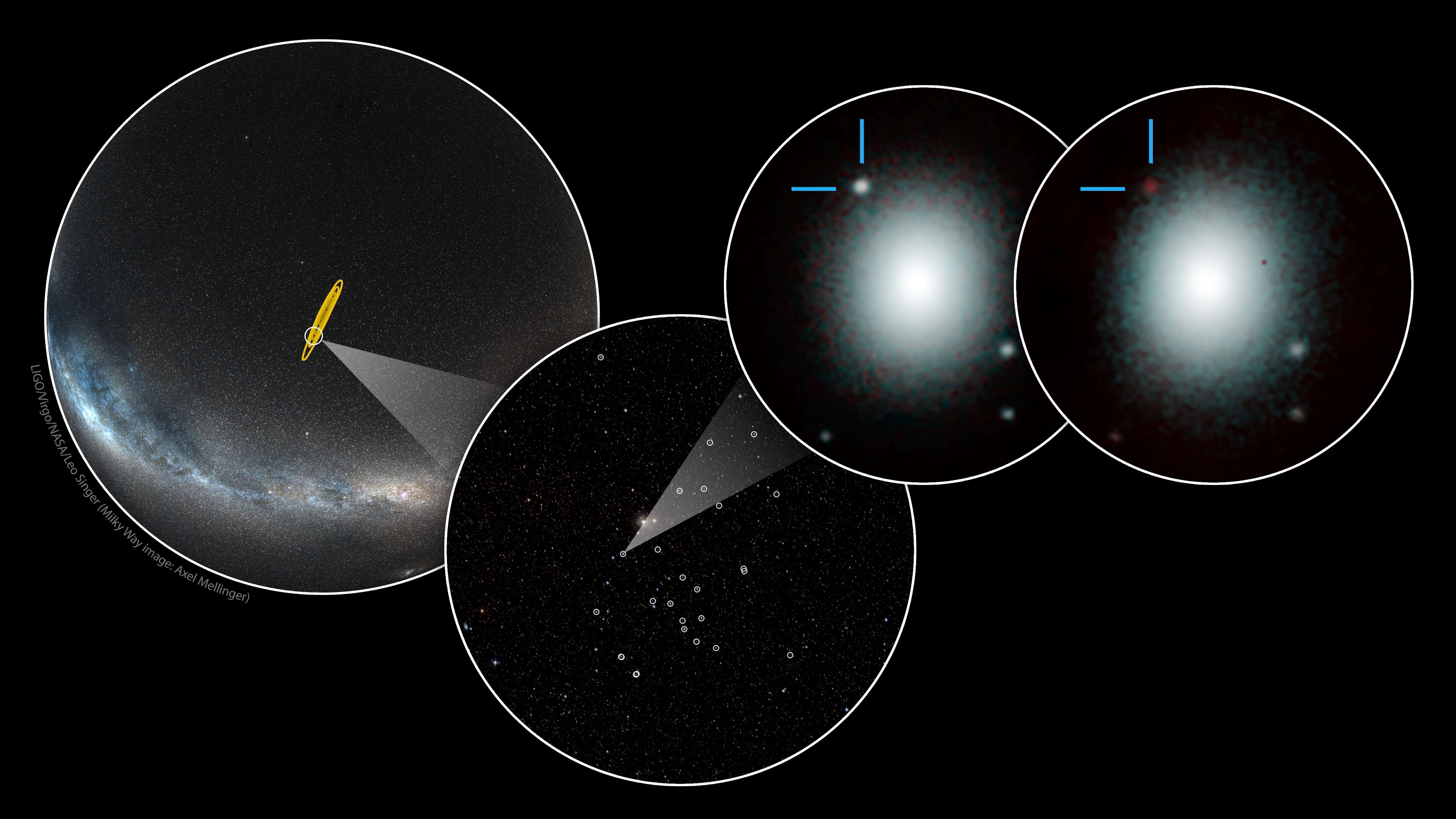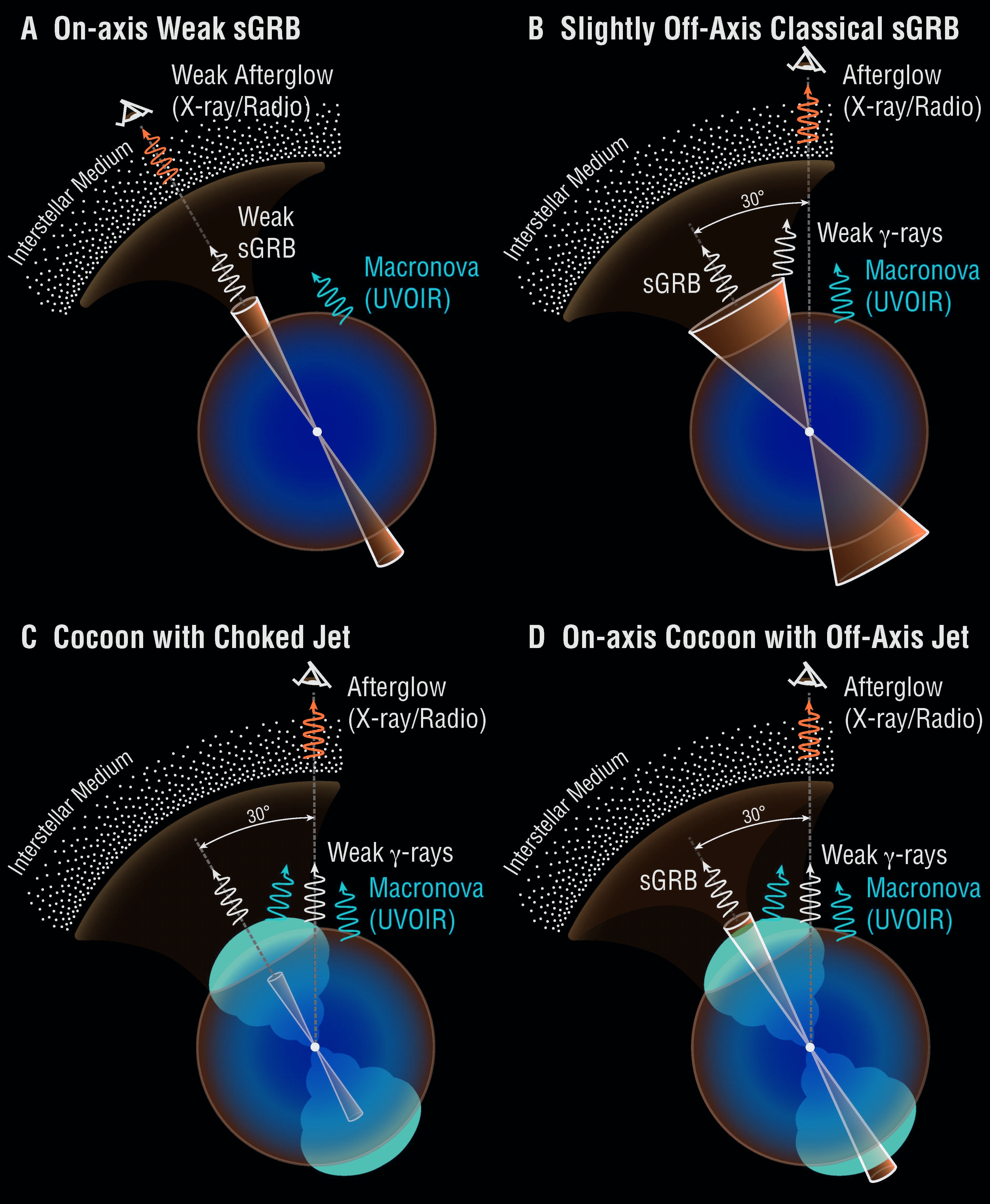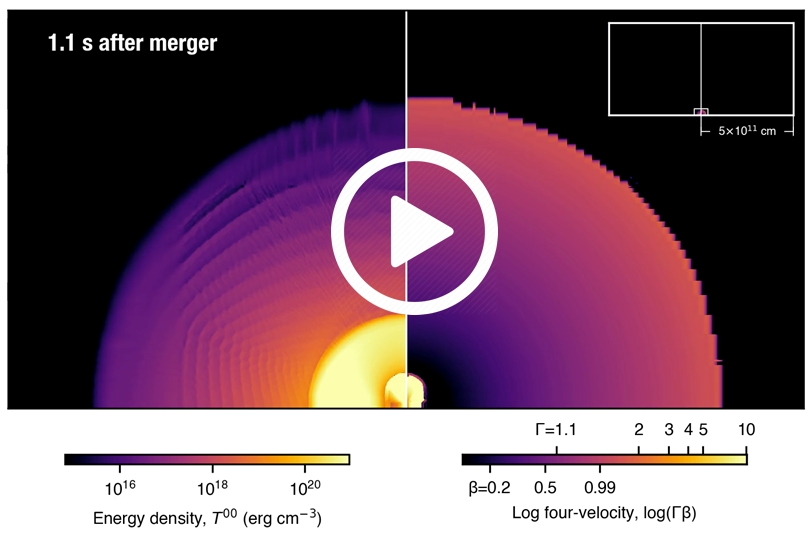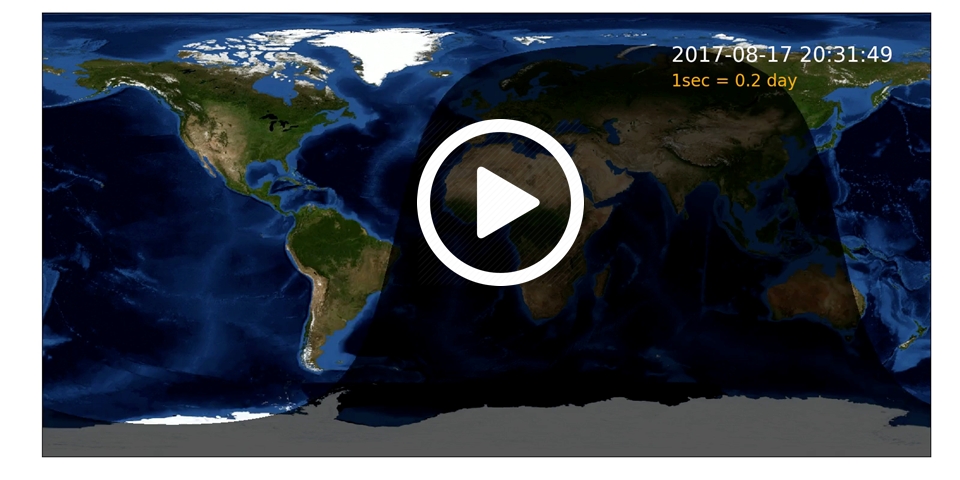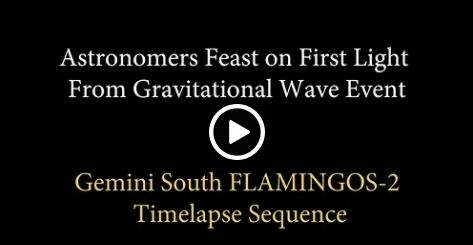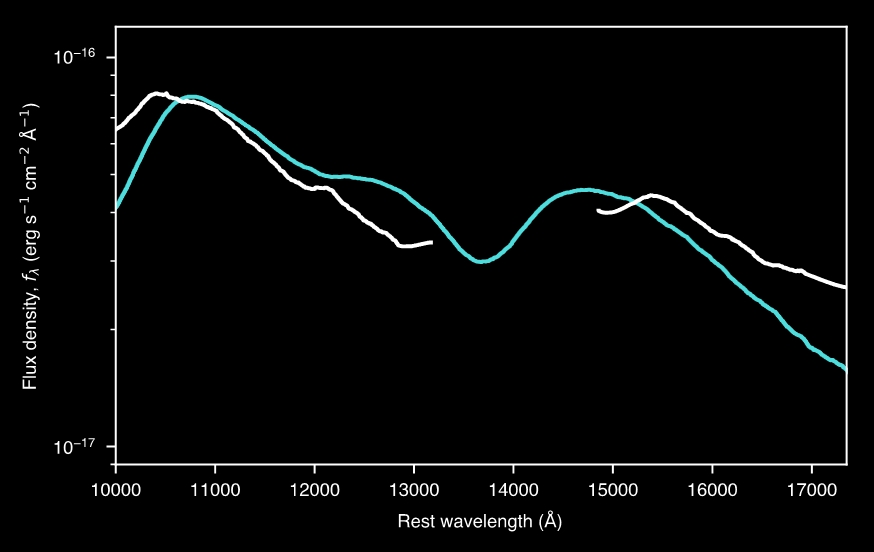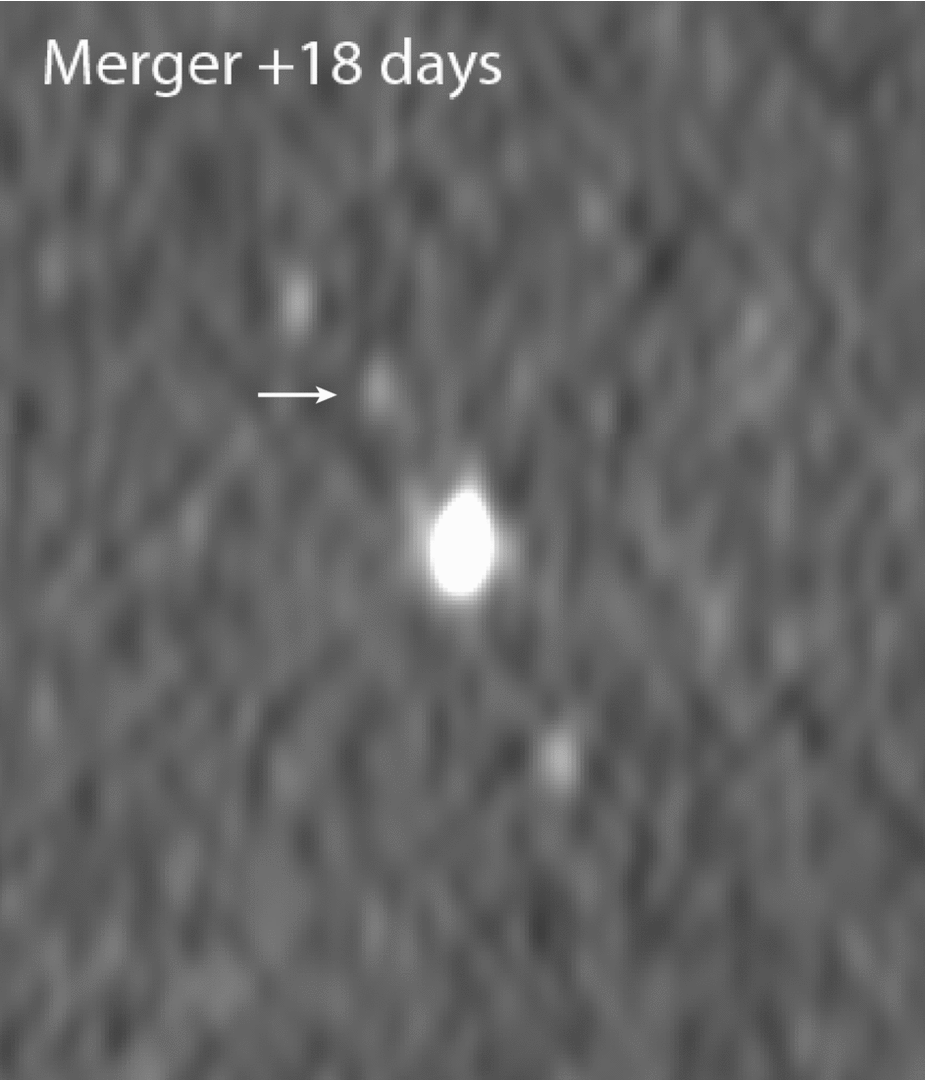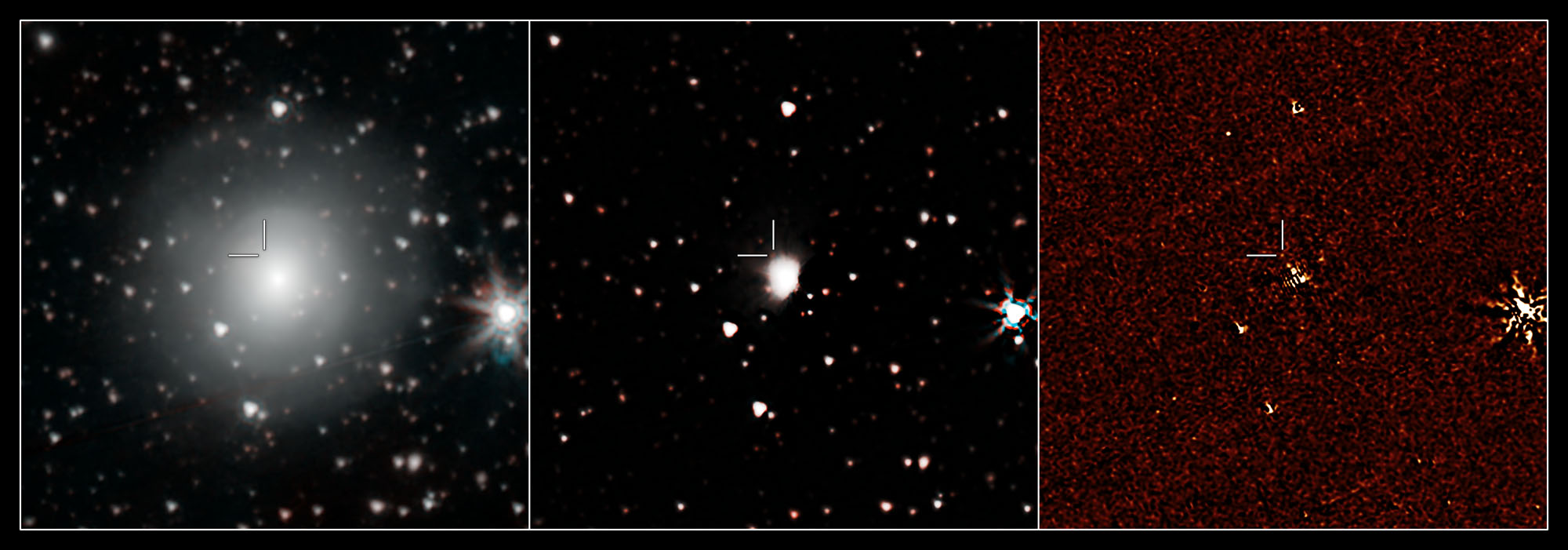2017
16 OctCaltech-led LIGO and astronomy teams strike gold
On August 17, 2017 scientists for the first time detected both the ripples in space and time known as gravitational waves as well as light produced and emitted during the same cosmic event: the spectacular collision of two neutron stars. Neutron stars, formed when massive stars explode in supernovas, are the smallest, densest stars known to exist, with a teaspoon of neutron star material having a mass of about a billion tons.
The light-based detections in the seconds, hours, days, and weeks that followed—which included Caltech-led observations in the infrared, X-ray, ultraviolet, and radio waves—show that the collision of the neutron stars released newly synthesized heavy elements into the surrounding universe, providing the first concrete proof that such smashups are the birthplace of half of the universe's elements heavier than iron, including gold and platinum.
Using the flood of data from across the electromagnetic (EM) spectrum obtained in the aftermath of the merger, Caltech astronomers have developed a new concordant picture of the dynamics of neutron star mergers and their evolution. The EM findings, coordinated by the Caltech team, are described in a trio of papers appearing October 16 in the journal Science.
The gravitational-wave discovery was made with the twin Laser Interferometer Gravitational-wave Observatory (LIGO) detectors. As the pair of neutron stars spiraled closer and closer together, they began to emit gravitational waves that were measurable for tens of seconds by LIGO's instruments before the inevitable cataclysm, starting at 8:41 a.m. eastern daylight time (5:41 a.m. Pacific daylight time). About two seconds after the gravitational waves ended, a bright flash of light, in the form of gamma rays, was detected by NASA's Fermi space telescope.
"We quickly established that the two stars were each less than around twice the mass of the sun, putting them in the typical mass range of neutron stars," says Professor of Physics Alan J. Weinstein, head of Caltech's astrophysical data analysis group for LIGO. Although black holes can, in theory, have masses as low as calculated for the merging objects, the coincident gamma-ray burst suggested that the stars had to have been made of matter, which can, unlike black holes, emit light. Later studies by Caltech and the LIGO Scientific Collaboration (LSC), a group of more than 1,200 scientists worldwide, found some evidence that the material in each of the stars was being torn apart by the gravity of its companion in a way that black holes could not.
"The detection of gravitational waves from a binary neutron star merger is something that we have spent decades preparing for," Weinstein says. "On that morning, all of our dreams came true."
"Caltech's investment in LIGO since the 1990s paid off handsomely," says Caltech's Albert Lazzarini, deputy director of the LIGO Laboratory. "Our laboratory's data analysis team was involved from the first hint of a detection through the issuing of the first alert to our astronomy partners, and Caltech astronomers made valuable follow-up observations across the entire EM spectrum."
A long-standing goal of the LIGO project has been the development of multi-messenger astronomy—the near-simultaneous observation of cataclysmic events such as neutron star mergers or supernova explosions in both gravitational waves and light, providing details about the astrophysics of these phenomena that can't be revealed through either alone. Toward this end, LIGO is set up to immediately alert the astronomical community when gravitational-wave detections are made by the twin observatories, located in Livingston, Louisiana, and Hanford, Washington.
With the August 17 event, dubbed GW170817, this alert was somewhat delayed when, due to a glitch, the gravitational-wave signal first noted by the Hanford detector was not immediately evident in Livingston data, but the Hanford signal triggered a deeper analysis of the data that quickly located the signature in the second detector. "Fermi's observation of a gamma-ray burst at nearly the same time added to the excitement and urgency of the moment," Weinstein says. At around 7 a.m. PDT, a little more than an hour after the gravitational wave arrived at the LIGO observatories, astronomers were notified about the event.
Among those to get the call was Caltech assistant professor of astronomy Mansi Kasliwal (MS '07, PhD '11), leader of the NSF-funded Global Relay of Observatories Watching Transients Happen (GROWTH) project. GROWTH is a worldwide network consisting of approximately 100 astronomers operating 18 telescopes on six continents who work together to track cosmic transients—extremely bright flashes of light, a million or more times brighter than the sun, that suddenly appear in the night sky and then quickly fade away. Realizing that time was of the essence, Kasliwal immediately began mobilizing the GROWTH team.
The LIGO gravitational-wave data—combined with information obtained by the Virgo detector in Europe—and Fermi's observations indicated that the source of GW170817 was within a fairly small patch of sky in the Southern Hemisphere. David Cook, a Caltech postdoctoral scholar in astrophysics, quickly compiled a prioritized list of around 50 possible galaxies that could potentially be the home of the neutron-star merger, and then the multiwavelength searches began.
Space-based telescopes, including NASA's X-ray and ultraviolet-sensing Swift Gamma-Ray Burst Mission led by principal investigator S. Bradley Cenko (PhD '09), began marching down the galaxy list, looking for the source. NASA's NuSTAR (Nuclear Spectroscopic Telescope), led by Fiona Harrison, the Benjamin M. Rosen Professor of Physics and Kent and Joyce Kresa Leadership Chair of the Division of Physics, Mathematics and Astronomy, also got into the game.
Around 4 p.m. PDT, the Swope Telescope—the oldest and smallest of a collection of four optical telescopes at Carnegie Observatories' Las Campanas Observatory in Chile—detected a bright optical counterpart to the gamma-ray burst and gravitational-wave signals, in a galaxy called NGC 4993.
Within about an hour of the optical counterpart discovery, infrared photons were detected by the Gemini South telescope, also in Chile. These observations were of particular interest because they could provide information about the chemical composition of the matter emerging from the merger and, astronomers hoped, might help solve a long-standing celestial mystery: the origin of the universe's heavy elements.
Scientists know where the lighter elements in the periodic table are synthesized: most hydrogen and helium come from the Big Bang, and elements up to iron are fused in the cores of stars. But the origin of half the elements heavier than iron has been uncertain. Astronomers have long suspected that they are synthesized in neutron-star collisions through rapid capture of neutrons— what is known as r-process nucleosynthesis—but had no proof.
Continued infrared monitoring by an array of ground-based telescopes found features in the infrared spectra indicative of chemical elements produced by the neutron capture process. "For the very first time, we see unequivocal evidence of a cosmic mine that is forging about 10,000 earth-masses of heavy elements, such as gold, platinum, and neodymium," Kasliwal says.
A week after it was first detected, GW170817 was arguably the best-studied cosmic transient event in history. But it still offered surprises. For one, X-ray and radio telescopes, despite intensive searches, had found nothing.
Kasliwal's colleague, theorist Ehud Nakar of Tel Aviv University, pointed out that the absence of X-ray and radio emissions fit a model in which the ejected material from the merged neutron stars produced a blast wave that interacts with the interstellar medium but with a time lag. If the model was right, he said, X-rays and radio emissions were days away.
Right on schedule, a handful of X-rays were detected by NASA's orbiting Chandra X-ray Observatory nine days after the merger; 16 days post-merger, Caltech assistant professor of astronomy Gregg Hallinan and his colleagues picked up the first radio photons with the Very Large Array, a collection of 27 radio telescopes in New Mexico operated by the National Radio Astronomy Observatory. "The radio emission arrives last but persists much longer than emissions at other wavebands," Hallinan says. "Radio comes late, and it comes slow, but it brings amazing information about the cosmic cataclysm."
Other puzzles remained. The brief gamma-ray burst—lasting less than two seconds and of a type known as a "short" gamma-ray burst—occurred more than 10 times closer to Earth than any other whose distance was known, but was unexpectedly weak; the ultraviolet and optical signals were oddly bright and faded fast.
A model developed by Kasliwal and her colleagues "tries to make sense of all of this," she says. In the model, the two neutron stars, as they spiral toward each other, throw off a huge amount of material, equivalent to the mass of about 10,000 Earths. When the neutron stars actually merge, a jet of gamma rays is released into all that material. The material engulfing the jet forms what Kasliwal calls a pressurized "cocoon," and the jet gets stuck in the cocoon. "When the cocoon eventually breaks out of the material, you get gamma-ray emission that's wimpy," she says.
The cocoon also explains other details of the event, such as the initial bright blue flash observed at ultraviolet and optical wavelengths, and the delay in the appearance of X-rays and radio waves.
Hallinan is planning continued radio observations over the next year or two, because this radio emission—which will be around long after all of the other wavelengths have faded—is the most important diagnostic of the energetics and environment of the explosion, and may reveal how much energy was in the explosion, how much mass was ejected, if a jet actually appeared, and if the merger produced conditions that will influence future star formation, among other questions. Observations are also underway with a network of radio dishes spread across the globe that form a telescope with a diameter comparable to the size of the earth. The unmatched spatial resolution of this technique will enable Hallinan’s team to directly image the expanding debris of the explosion.
"The story that is unfolding for this event is more complete than for any previous event in astronomical history," Hallinan adds. "The gravitational waves elucidate the strong gravity environment of the merger, invisible to telescopes. The electromagnetic radiation tells us how the explosion evolves, forms the heavy elements, and then interacts with and enriches the surrounding interstellar medium. This complete story—both hearing and seeing the violent universe—is the gift of multi-messenger astronomy."
Meanwhile, scientists at the LIGO sites, including alums Anamaria Effler (BS '06) and Jenne Driggers (PhD '15) have devised subtle ways to remove acoustic noise pollution that currently limits the detectors' sensitivity to neutron-star mergers. "Throughout most of 2018, new hardware will be installed to move LIGO closer to its fundamental limits," says Caltech professor of physics Rana Adhikari.
"We even more eagerly anticipate the detection of gravitational waves from different kinds of known, extremely energetic astrophysical objects, like rapidly spinning pulsars, supernovae, and neutron-star quakes," Weinstein says, "and, especially, from heretofore unknown astrophysical objects."
Written by: Kathy Svitil
Scientific Publications
The trio of papers describing the multiwavelength research associated with GW170817 event are published in the journal Science.
Illuminating gravitational waves: A concordant picture of photons from a neutron star merger
Kasliwal et al., Science 2017,DOI: 10.1126/science.aap9455
Swift and NuSTAR observations of GW170817: Detection of a blue kilonova
Evans et al., Science 2017, DOI: 10.1126/science.aap9580
A radio counterpart to a neutron star merger
Hallinan et al., Science 2017, DOI: 10.1126/science.aap9855
Related Releases and Multimedia
Press Releases
Gemini Observatory Press Release
University of Stockholm Press Release
NCU (Taiwan) Press Release (In Chinese)
Tel-Aviv University Press Release
University of Sydney Press Release
University of Portsmouth Press Release
Article in "The Conversation" co-authors by GROWTH co-investigator David Kaplan (UWM)
Multimedia
Additional resources from Ligo/Virgo Collaboration
Video: CAASTRO taking part in radio detection from GW170817
Video: Neutron Star Collision (NASA/GSFS)
Video: Colliding Neutron Stars (NRAO/AUI/NSF)
Contact
Iva Kostadinova
GROWTH Communications and Media Contact
ivonata@caltech.edu
+1 626 395 2952
Science Contacts
Mansi Kasliwal
GROWTH Principal Investigator
mansi@astro.caltech.edu
+1 626 395 1575
Gregg Hallinan
Caltech Astronomy Professor
gh@astro.caltech.edu
+1 626 395 4726

